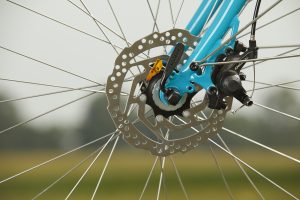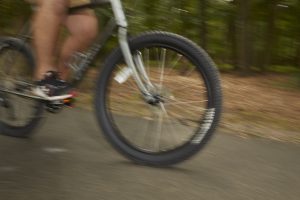Athletics is often associated with a sleek body in sports such as cycling, where endurance is essential, but heavy/older/larger people can also do it. Heavy riders can improve their cycling skills with our tips for heavy riders and make them even more fun with a few changes.
Heavy riders need to rely on strength, leverage, and weight benefits. Careful bike selection, disciplined shape, improved muscle efficiency, and additional training will make heavy riders more comfortable, enhance performance, and ride faster.
Heavy riders must make changes to both the bike and the technique. Understanding the reasons behind more specific techniques and guidelines will help you enjoy your ride. Here are some important tips for heavy riders.
Selecting the Right Bike for Heavy Riders:
Bikes with small, thin wheels and frames are great for reducing drag but not for heavy riders. While knowing the bike manufacturer’s recommended maximum weight is essential, many other specifications can help you make informed decisions when choosing a bike. When choosing the right bike for you, you must consider all the frame materials and sizes, wheel widths and diameters, spokes, brakes, and seats.
Most luxury bike stores offer professional bike accessories. This is an excellent option for many bikers to consider. Whether going to the pros or choosing your bike, you’ll want to acquire as much knowledge as possible. Most bicycle store employees have no experience as heavy cyclists, so it is very helpful to check the weight limit of your bicycle before entering the store. The specifications are so important and unique that it is difficult to find a suitable bike without proper knowledge.
Zize Bikes offer perfect bikes for heavy riders, especially overweight people.
Bike Frame:
Starting with the frame, it should be sturdy and durable, but the rider is already heavy, so it should be as light as possible. The frame material needs to be more flexible before it becomes a breakpoint. Typical frame materials available in the market are steel, carbon fiber, aluminum, and titanium. Steel and titanium are the best options for heavy riders because of the flexibility and strength that allows for higher weight limits.
There are two types of steel used for bicycle frames: carbon and chrome. Both types are incredibly sturdy and last longer than most other materials. Carbon is the most common type of steel, but chromium is more high-tech. Chromoly is highly flexible and can be broken or shaped to reduce weight in ways that carbon cannot. Titanium is a more expensive option but also a lighter material. Titanium absorbs weight and impacts very well without impact. The high-end titanium bike frame has the highest strength-to-weight ratio if you can afford it.
Both aluminum and carbon fiber are very common, cheap, and lightweight. However, they lack the toughness of the more expensive metals and do not have the durability required for heavy riders.
Tiers & Wheels:
The number of spokes is important for structural integrity while considering the wheel. For larger wheels, more spokes are needed to maintain stability. In general, try to get a wheel with at least 36 spokes to support heavier weights. For heavy riders, the wider the tires, the better. The wider tires offer a more comfortable ride and are less likely to have a flat tire. For best performance, the tires need to be fully inflated. The heavier the weight on the tire, the higher the air pressure.
All tires have recommended air pressures within range. If you are a heavy rider, inflate your tires at the upper limit of the range to prevent flat tires and keep your bike at its best performance. Wider tires can handle the required high pressures much better than thin tires.
Reduce Training and Train Smarter:
In the beginning, recall your two-year training history before you start your workout. It will help you to understand how much cycling is needed. These trainings are performed at varying intensities to bring about specific physiological changes.
Improve Riding Efficiency:
Efficiency is defined by the work done in relation to the energy consumed. People want to consume the same amount of energy and drive faster. You can do this by:
- Engaging all muscle fibers: Muscles, such as the gluteal, comprise several motor units, which are bundles of muscle fibers. Each motor unit has nerves that send a message from the brain to the fibers to ignite. Imagine eight people on a boat competing with the other eight to row. However, if all eight rowers in the boat do not stroke the oars simultaneously, the other boats will be at the oars. Your muscles are the same, but their fire is not naturally regulated. It can improve muscle fiber coordination with sprints that require maximum power. During the run, 2-3 30-second sprints are fine, with at least 5 minutes of recovery between each recovery and more.
- Getting a suitable cycle: Selecting the right bike can increase effectiveness by 5%. Pulling in the gluteal muscles: Almost all force is applied above and below the pedal stroke. You can get more power by using the gluteal and quadriceps muscles. Imagine pushing your knees towards a dumbbell or kicking a soccer ball to get an idea of how your gluteal muscles are used without using your quadriceps. Don’t try too many anklets, as calves and hamstrings are powerless. It’s just a waste of energy.
- Strengthening the core: Your feet are like levers, and your core is the fulcrum. If the fulcrum (core) is moving, it consumes energy instead of using it. Strengthening the core means strengthening the deep muscles that surround and stabilize the core like a belt. Crunches do not strengthen these muscles.
Words for you!
If you are an overweight person like me, a trusted brand like Zize Bikes is exclusively for you! Here you can have all kinds of bikes for heavy riders. Visit our website for more information, and we will be honored to help you select the right bike.







